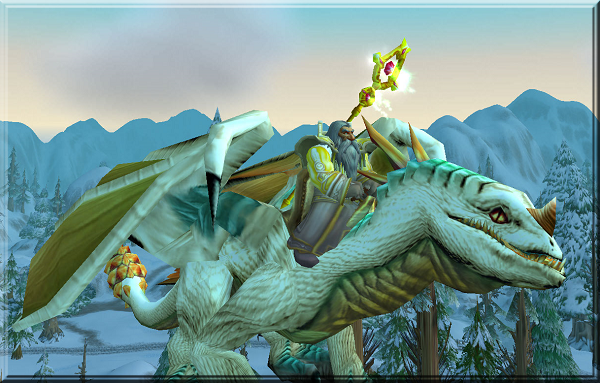Author’s Note: I wrote this article for my original blog in 2014. As far as I can determine, this was my very first “blog” article anywhere.
Intro and Disclaimer
To delay the risk of becoming a one-trick commentary, I wanted to avoid turning this blog into a World of Warcraft write-up. It’s the most pervasive game I’ve played over the past decade, being a Warcraft fan since the mid-90s. However, there is presently a low-hanging fruit of the most large and delicious type, simply too hard to ignore – the apparent decision to disallow personal flight from Warcraft’s next expansion, Warlords of Draenor. It seems too good to pass up for a first article!
Flying and Subject Matter Defined
It may help to level-set and give perspective on flying. In World of Warcraft, there are three main ways a player may lift off from the ground to achieve a sustained airborne state:
- Flight Paths
- Objective-Related Flight Vehicles
- Freeform Flying, or Personal Flying
The first, flight paths are a very common mechanism in MMOs. In WoW, a flight path is a means to quickly travel from one point to another (often via middle connecting points). Typically flight paths are spread far enough away from each other to make their lines the economically-faster way to travel over ground means. The path is pre-set between any two nodes and lifts your character significantly off the ground. You lose effective control of your character during this type of flight with the noteworthy exception of being able to change your camera angles and views (just as you can on the ground). Elevated flight paths plus the freedom to change your camera view offer broad and visually appealing views of the Azerothian, Kalimdorean, Draeni, Northrendish, and Pandarian landscapes.
Objective-related flight vehicles are used to achieve quest obectives and even to defeat dungeon and raid bosses. The earliest example of this type of flight, that I can recall, is from the Warcraft’s first expansion, The Burning Crusade, where you could go on bombing runs in Hellfire Peninsula. The level of control offered players vary by quest. Some are bombing runs where the player is merely a passenger (similar to a flight path) with either an item or hotkeys to target ground or air-based objectives. Others allow the player to fly freely within a certain space zone, equipped with abilities pertinent to the accompanying quest’s objectives, or dovetailing with the boss’s mechanics.
Freeform flight (personal flight) allows you to “mount” a flying-enabled creature or machine and travel anywhere along the X, Y, and Z axes until you reach boundary or possibly a hazard. There are no hard game objectives associated with this type of flight, and is ultimately a convenience to allow players the fastest means possible of travelling in a zone or to adjacent zones. Freeform flying is allowed only in certain (albeit most) zones as of the current expansion, Mists of Pandaria.
It is this freeform flight that has become a topic of recent discussion. Blizzard stated late in 2013 that flight will not be allowed in the new zones until the first major patch of the next expansion, Warlords of Draenor. And recently there have been hints that flying may not be allowed altogether in WoD.
Origins of Warcraft Flying, pre-World of
For perspective on the ability to fly during the Warcraft saga, we should start with the real-time strategy (RTS) games prior to World of Warcraft. The very first game, Orcs and Humans, had no flying (at least none I can recall). It was, by today’s standards, a straightforward early mid-90s RTS. The arrival of Warcraft II saw the introduction of flying transports (e.g. zeppelins) and flying fighting units, like gryphons. Warcraft III, as well as Blizzard’s sci-fi offshoot Starcraft, continued the use of flying units for both moving around maps and fighting.
A key feature of these RTS flying units is that they often had a powerful ability or two coupled with one or more crippling hindrances. An example is the Starcraft battlecruiser, with its powerful Yamato cannon and high hit points, offset by its extremely slow speed and firing prep time.
Flying in the Original World of Warcraft
With the exception of the very limited goblin zeppelins for cross-continent Horde travel, the only flying available in WoW from its launch until its first expansion was through flight paths. Travel consisted of walking, riding your (amazingly expensive) ground mount for short distances, flight paths for cross-zone destinations, using your hearthstone for teleporting back you your home inn, channeling meeting stone summons, and a few class-specific travel spells (warlocks, mages). The wrapper-based flight vehicles weren’t introduced until WoW’s third expansion, Wrath of the Lich King (remember parachuting at the shores of Northrend?). Personal flight, as being debated for Warlords of Draenor, did not exist for the first several years of WoW’s existence.
Enter Player Flight
Early in WoW’s life there was the expectation that players would be able to fly their very own drakes. This hope was manifested in The Burning Crusade, allowing players who achieved the (then) new maximum level of 70 to purchase the flying skill. The leveling experience from 58 through the end of 69 was ground based (with the exception of flight paths and some quests). A reputation grind in one of the expansion’s end zones provided the means to obtain a nether drake. Flying was only possible in Outland (the expansion’s continent).
Player flight was primarily a means of convenience. It allowed you to move question, at your own discretion, to anywhere in Outland (and later Northrend, the Cataclysm zones, and Pandaria) without the need for flight paths. They also made the gathering of resource nodes efficient, allowing players to bypass ground-based monster threats while farming resources.
Player Flight Expands
As the years passed, more and more flying mount types were added, and even their speed was increased to maximum of 310% over ground travel. Gaining flight appeared to be an established luxury of winning the level cap for each new expansion (the conditions for which would be gradually tweaked from patch to patch). This paradigm was shattered in WoW’s third expansion, Cataclysm. It introduced flight in most classic zones (most of the Eastern Kingdoms and Kalimdor) and allowed flying in the new expansion zones while leveling (except Vashj’ir, the sea zone). More than any other past precedent, this near-solidified players’ expectations that personal flight was a key part of the game.
Returning the Genie to the Bottle
Mists of Pandaria, the fourth expansion, saw flight’s integration return to its traditional structure, i.e. only being available at maximum level. However, Mists also introduced a new twist in later patches: zones that disallowed flight altogether (yes, you could go back to the introduction of Isle of Quel’Danas in The Burning Crusade, but that zone was reasonably assumed, strictly from a build perspective, to be an extension of the flightless Ghostlands and Eversong Woods). This started with the Isle of Thunder and ended with the Timeless Isle. In both zones, only land-based movement was allowed. And given each zone’s designed, it is highly unlikely that leveling ever will be allowed in either.
The Isle of Thunder is chalk-full of quests and monsters, making transportation and movement part of the gaming challenge. You are able to hide in certain parts of the zone via preset invisibility nodes. Available potions laid in certain sections as well as auto-disguises aide players in navigating through the environment.
The Timeless Isle appears to be Blizzard’s take on Guild Wars 2-type landscape and zone design. Much of the island/zone is terra-formed into puzzles and challenges. Allowing flight in this zone would render these features mute, or trivial.
Implications to Gameplay Design
Perhaps more than any other feature, the allowance or disallowance of personal flight impacts the design implications of every zone. Flight allows for quick access, fast farming, and bypassing content. A decision to completely prohibit personal flight in a zone means that a Timeless Isle and all its puzzles can be built without devoting energy and time to wondering how a flying player may implicate those puzzles. Likewise, allowing flight, or eventually allowing flight, means the developers have to acknowledge from the start that a zone introduced as ground-only will eventually have a mix of walking levelers and flying end-gamers. This could lead to unforeseen consequences, such as max-level players providing unintended assistance to leveling players.
Designer’s Choice
All game mechanics have consequences on a game’s design. Choosing to explicitly allow certain activities and implicitly deny others is what game design is all about. Take two examples in the games Skyrim and Titanfall.
Skyrim, part of The Elder Scrolls series, is an expansive single-player game. The level of detail and zone size is astounding. These features, which give the game so much appeal, are made possible because it has no multiplayer component. If the designers chose to incorporate multiplayer in any form, they would have to devote time and energy to ensuring the single-player and multiplayer experiences worked together, plus consider the sizing of their rendering servers, among many choices. That would have been time and investment money removed from strengthening the single-player experience.
Titanfall, recently released as of this writing, is like the reverse of Skyrim by being a multiplayer-only game. First-person shooters usually build a single-player campaign, involving story design, cut scenes, and delineation from the multiplayer experience. The game’s developer, Respawn, made a decision to devote its resources fully to multiplayer.
If either of these games had incorporated respective multiplayer or single-layer modes, it would have meant a diminished strength in their core mode, or a significant delay in product releases, and possibly even overall lower-quality gaming experiences (both are of the highest grade).
Preference to the Saga
Although I enjoy personal flight in Warcraft, I also defer to the game’s developers in how to make the best experience possible for Warlords of Draenor. If the lack of flight means expanding on the creative concepts introduced with The Isle of Thunder and the Timeless Isle, I more than looking forward to that. Blizzard is a proven high-quality gaming operation, so I don’t doubt that whatever the final choices are, chances are very good the end product will be something fans of Warcraft will enjoy. Sure, they make mistakes sometimes (I’ll save a retrospect of Cataclysm for another day), but they have been producing hit games for 20 years and have earned the benefit of the doubt.
Every MMO expansion is effectively a new game. MMO expansions normally depreciate all prior content, either making that content trivial, or retooling the content for the new expansion. Flight may disappear in the next expansion, but could return with a vengeance in a futre expansion.
Involvement in the ongoing saga of Warcraft is what I want. I want a good story integrated with awesome gameplay mechanics. I can’t wait to learn how Garrosh escapes his Pandarian captors, finds a route to “past” Draenor, and attempts to rebuild “his” Horde. And I want to be there both watching and being part of the story. In this context, the question of personal flight seems secondary at best, and once Warlords concludes, my guess is the matter will be even less than that.






